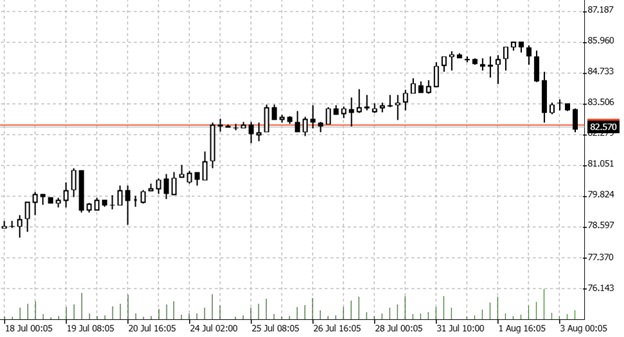

03.08.2023 – Is the bull market in oil now over? New speculation surrounding Saudi Arabia has put the brakes on the rise. Now things are getting exciting: the OPEC+ Joint Ministerial Monitoring Committee will be meeting shortly.
The oil price, which knew only the way north since the end of June, has recently turned south. Here is the four-hour chart for Brent.

Source: Bernstein Bank GmbH
The latest trigger for the setback was a report from Bloomberg, according to which the Saudis could now relax their production cuts again. After all, Brent had crossed the price of 85 dollars per barrel. Higher quotas could help the kingdom regain lost market share. In addition, refineries around the world urgently needed supplies.
The Saudis had announced in June that they would cut production by 1 million barrels per day (bpd). In addition, Riyadh reiterated that it would also produce 1 million bpd less oil in August, following July. As a result, and due to production problems in Nigeria, Angola and Libya, OPEC output has fallen to its lowest level since 2020, according to Oilprice.com.
Saudis probably want $90
Reuters had just reported, citing insiders, that the cartel would not change its production policy. According to Investing.com, this will be joined by further cuts in other OPEC+ countries. Many analysts had recently believed that Saudi Arabia would maintain its cuts in September. “The kingdom will want to see a protracted rise toward $90 a barrel and possibly improvement in Chinese economic data to start considering putting the 1 million barrels per day back into the market,” Tamas Varga of PVM Oil Associates told Bloomberg news agency, for example.
Experts at National Australia Bank also expressed their views in this direction. In an analysis on Tuesday, they said: “Oil prices are on track to hit 2023 price highs in our view. The Organization of Petroleum Exporting Countries (OPEC) meeting this Friday is a potential catalyst for the outlook where we expect Saudi Arabia’s voluntary supply cuts to be extended another month.” There is some confusion about the date, by the way: the online meeting has been postponed to Saturday, according to Reuters.
Fewer reserves in the USA
And also from the USA there had just been quite bullish impulses: Thus the stocks slipped this week by fabulous 15.4 million barrels – the largest minus of all times. And nobody could explain the data of the American Petroleum Institute, judged Oilprice.com. Analysts had expected a drop of only 900,000 barrels.
Also, the much-watched stockpiles at Cushing, a backwater in Oklahoma, fell by another 1.76 million barrels, after already dropping by 2.34 million barrels the week before. The rig count from Baker Hughes in the U.S. showed a stagnant, low level: only 529 wells were active at the end of July, compared to 605 a year ago and 623 at the beginning of the year.
Our conclusion: The oil price stands and falls with the decision of the Saudis. America is unlikely to jump into the Arab gap. Keep an eye on the real-time news on the OPEC meeting – Bernstein Bank wishes successful trades and investments!
___________________________________________________________________________________________________________________________
The content of this publication is for general information purposes only. In this context, it is neither an individual investment recommendation or advice nor an offer to purchase or sell securities or other financial products. The content in question and all the information contained therein do not in any way replace individual investor- or investment-oriented advice. No reliable forecast or indication for the future is possible with respect to any presentation or information on the present or past performance of the relevant underlying assets. All information and data presented in this publication are based on reliable sources. However, Bernstein Bank does not guarantee that the information and data contained in this publication is up-to-date, correct and complete. Securities traded on the financial markets are subject to price fluctuations. A contract for difference (CFD) is also a financial instrument with leverage effect. Against this backdrop, CFD trading involves a high risk up to the point of total loss and may not be suitable for all investors. Therefore, make sure that you have fully understood all the correlating risks. If necessary, ask for independent advice. CFDs are complex instruments and are associated with the high risk of losing money quickly because of the leverage effect. 68% of retail investor accounts lose money trading CFD with this provider. You should consider whether you understand how CFD work and whether you can afford to take the high risk of losing your money.7
